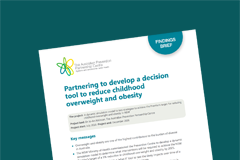Partnering to develop a decision tool to reduce childhood overweight and obesity
The NSW Ministry of Health commissioned the Prevention Centre to develop a dynamic simulation model to determine what interventions will be required to achieve the NSW Premier’s target of a 5% reduction in childhood overweight and obesity by 2025. This PDF summarises initial insights from the model relevant for policy and practice decision makers.
Key messages
- Overweight and obesity are one of the highest contributors to the burden of disease in Australia.
- The NSW Ministry of Health commissioned the Prevention Centre to develop a dynamic simulation model to determine what interventions will be required to achieve the NSW Premier’s target of a 5% reduction in childhood overweight and obesity by 2025.
- A dynamic simulation model is a ‘what if’ tool to test the likely impacts over time of a range of policies and programs to address complex issues.
- Initial insights from the model have indicated what combination of interventions is required to meet the Premier’s target. Interventions include improving built environment infrastructure, food policy interventions, school interventions and clinical service delivery.
- The participatory nature of the model-building process is pioneering and has engaged stakeholders who will be central to decision-making to address childhood overweight and obesity in NSW.
